2020 MERCEDES-BENZ S-CLASS COUPE wheel
[x] Cancel search: wheelPage 377 of 542
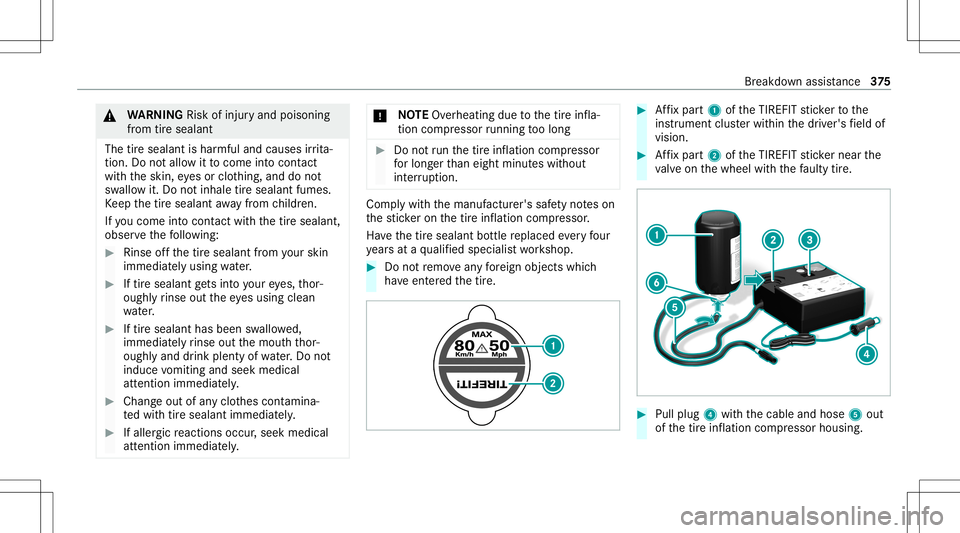
&
WARNIN GRisk ofinju ryand poiso ning
fr om tiresealan t
The tiresealan tis har mfuland caus esirrita ‐
tio n.Do notal lo w itto come intocont act
wi th theskin ,ey es orclo thing, and donot
sw allo wit. Do notinhale tiresealant fumes.
Ke ep thetir esealant away from childr en.
If yo uco me intoco ntact withth etir esealant,
obser vethefo llo wing: #
Rinse offth etir esealant from your skin
imm ediat elyusin gwa ter. #
Iftir eseal antgets int oyo ur eyes, thor‐
oughl yrinse outth eey es using clean
wa ter. #
Iftir eseal anthas been swallowe d,
immediat elyrinse outth emout hth or‐
oughl yand drink plenty ofwa ter.Do not
ind uce vomiting andseek medica l
att ention immedi ately . #
Cha ngeout ofanyclo thes con tamina‐
te dwit htir esealant immediat ely. #
Ifall ergic react ionsocc ur,seek medical
att ent ion imm ediat ely. *
NO
TEOverhea ting dueto thetir einf la‐
tion compressor running toolong #
Donotru nth etir einf lation compressor
fo rlong erthan eight minutes wit hout
int erru ption. Com
plywit hth emanuf acturer'ssafetyno teson
th est icke ron thetir einf lation compressor .
Ha ve thetir esealant bottle replaced everyfour
ye arsat aqu alif ied spec ialistwo rkshop. #
Donotre mo veanyfo re ign obje ctswhic h
ha ve ent ered thetir e. #
Affix pa rt1 oftheTIREFI Tst icke rto the
ins trumen tclus terwit hin thedr iver's field of
vision. #
Affix pa rt2 oftheTIREFI Tst icke rnear the
va lve on thewheel withth efa ulty tire. #
Pull plug 4withth ecable andhose 5out
of thetir einf lation compressor housing. Br
eakdo wnassis tance 37
5
Page 386 of 542

Fo
rto wing, useato w rope ortow bar withbo th
axle son thegr ound. Donotuse tow bar systems
(/ page225). *
NO
TEDama getotheve hicle duetotow‐
ing away inc orrectly #
Obs erve theins truction sand noteson
to wing away. To
wing withara ised axle: towing should be
per form ed byato wing company.
Pe rm itted towing methods Ve
hicl eeq uipment/ towing
me thod Bo
th axle son thegr ound Fr
ont axle raised Re
ar axle raised
Ve hicles withaut omatic transmis‐
sion Ye
s,maximum 31mile s(50 km) at
31 mp h(50 km/h) No
Yes,ifth esteer ing wheel isfixe din
th ecent erposition withast eer ing
wheel lock
4MA TICvehicles Yes,maximum 31mile s(50 km) at
31 mp h(50 km/h) No
No38
4
Breakdo wnassis tance
Page 388 of 542
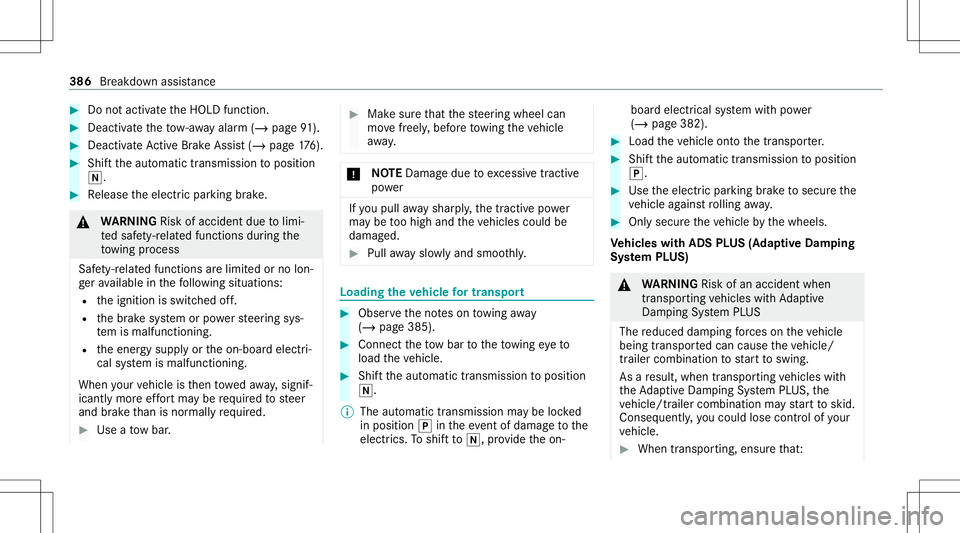
#
Donotacti vate theHOLD function. #
Deact ivat eth eto w- aw ay alar m(/ page91 ). #
Deac tivateAc tiveBr ak eAssi st(/ pag e17 6). #
Shif tth eaut omatic transmiss iontoposition
005C. #
Release theelectr icpar king brak e. &
WARNIN GRisk ofacci dent dueto limi‐
te dsaf ety-re lat ed func tionsdur ing the
to wing proce ss
Saf ety-re lat ed func tionsar elimit edorno lon‐
ge rav ailable inthefo llo wing situat ions:
R theignition isswitc hedoff.
R thebr ak esy stem orpowe rst eer ing sys‐
te m ismalfu nctioning.
R theener gysupply ortheon- boar delectr i‐
cal system ismalfunct ioning.
When your vehicle isthen towe daw ay,signif ‐
icant lymor eef fort ma ybe requ ired tosteer
and brak eth an isno rm allyre qu ired. #
Use ato w bar . #
Mak esur eth at thesteer ing wheel can
mo vefreely ,bef oreto wing theve hicle
aw ay. *
NO
TEDama gedue toexcess ive tracti ve
po we r If
yo upull away shar ply, thetractiv epo we r
ma ybe toohigh andtheve hicles couldbe
damag ed. #
Pull away slo wlyand smoo thly. Lo
adi ng the vehicl efo rtr ans port #
Obser vetheno teson towing away
( / pag e385). #
Connec tth eto w bar totheto wing eyeto
load theve hicle. #
Shif tth eaut omatic transmiss iontoposition
005C.
% The automatic transmis sionmaybe locked
in posit ion005Dintheeve ntofdama getothe
electr ics.Toshif tto 005C ,pr ov ide theon- boar
delectr icalsystem withpo we r
( / pag e382). #
Load theve hicle ontoth etra nspor ter. #
Shif tth eaut omatic transmiss iontoposition
005D. #
Use theelectr icpar king brak eto secur eth e
ve hicle agains tro lling away. #
Onlysecur eth eve hicle bythewheels.
Ve hicl eswith ADSPL US (Adap tiveDam ping
Sy stem PLUS) &
WARNIN GRisk ofan acci dent when
tr ansp orting vehicles withAd aptive
Dam pingSy stem PLUS
The reduced damping forc es on theve hicle
being transpor tedcan cause theve hicle/
tr ailer combination tostar tto swing.
As are sult, when transpor tingvehicles with
th eAd aptiveDam pingSy stem PLUS, the
ve hicle/tr ailercombination mayst ar tto skid.
Conseq uently,yo uco uld lose contro lof your
ve hicle. #
When transpor ting,ensur eth at: 386
Break down assis tance
Page 389 of 542

R
The vehicle hasbeen loaded onto
th etra nspor tercor rectly
R The vehicle issecur edatall four
wheel swit hsuit able tensi oni ng
st ra ps
R The maximum permissible speedof
35 mph(60 km/h) isno tex ceed ed
whe ntransp orting *
NO
TEDama getotheve hicle from secur‐
ing itincor rectl y #
Afterloa ding, theve hicle mustbe
secur edon allfour wheel s.Ot her wise,
th eve hicle could bedamag ed. #
Aminimum distance of4in (10 cm)
up wa rdsand 8in (20 cm) down wards
mus tbe kept tothetranspor tplatf orm. Tr
ans portle ve lis no tav ailable forth efo llo wing
ve hicles:
R Mer cedes- AMGvehicles
R Vehicles withMA GIC BODY CONTR OL %
Depending onthemodel, button1 isloca‐
te din thecon trol panel between thesteer ing
wheel andthedr iver's door . #
Toactiv atetranspo rtleve l:pr ess butt on
1.
Indic ator lam p2 lights up.
The vehicle israised by1.2 in (30 mm) com‐
par edtothenor mal leve l. #
Press butt on1 again and hold itforat lea st
fi ve seconds.
The vehicle israised from thera ised leve lto
th etranspor tle ve l.
The transpor tle ve lis reac hed when indicat or
lam p2 flashes andtheMax. Speed 22mph
displa ymessag eappear sin themultifunc tion
displa y.
The vehicle islowe redag ain inthefo llo wing sit‐
uation s:
R When drivin gfa ster than 22 mph(35 km/h).
R Aftersele cting adr ive pr ogr am using the
DY NA MIC SELE CTswitc h.
The vehicle isthen adjus tedto theheight of
th elas tactiv edr ive pr ogr am. #
Secur eth eve hicle onallfour wheel saf te r
loading . #
Todeac tivatetranspo rtleve l:star tth e
engine whentheve hicle isat ast ands till.
If transpo rtleve lis act ivat ed, indic ator lam p
2 flashes . Br
eak down assis tance 38
7
Page 395 of 542
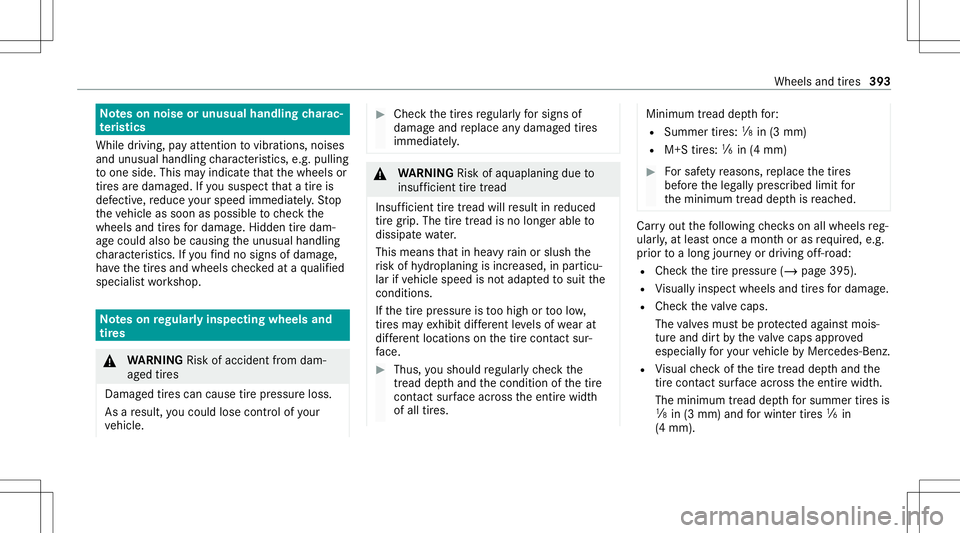
No
teson noise orunusua lhand lingcharac‐
te rist ics
While driving ,pa yatt ent ion tovibr ations, noises
and unusu alhandl ingcharact eristic s,e.g .pullin g
to one side. Thismayindicat eth at thewheels or
tir es aredamag ed.Ifyo ususpe ctthat atir eis
def ective, reduce your spee dimm ediat ely. Stop
th eve hicle assoon aspossible tocheckth e
wheels andtires fordama ge.Hid den tireda m‐
ag ecou ldalso be cau sing theunusual handling
ch aract eristic s.Ifyo ufind nosigns ofdamag e,
ha ve thetir es and wheels checkedat aqu alif ied
spec ialistwo rkshop. No
teson regular lyinspect ingwheels and
tir es &
WARNIN GRisk ofacci dent from dam‐
ag ed tires
Dama gedtir es can cause tirepr essur eloss.
As are sult, youco uld lose contro lof your
ve hicle. #
Chec kth etir es regular lyforsigns of
dama geand replace anydamag edtires
immediat ely. &
WARNIN GRisk ofaquaplani ng dueto
insuf ficie nttiretrea d
Insu fficien ttir etread willresult inreduced
tir egr ip. The tiretread isno long erable to
dissipat ewa ter.
This means that inhea vyrain or slush the
ri sk ofhydroplaning isincr eased, inpar ticu‐
lar ifve hicle speed isno tadap tedto suit the
condi tions.
If th etir epr essur eis toohigh ortoolow,
tir es ma yex hibit differe nt leve ls of we arat
dif fere nt locati ons onthetir econ tact sur‐
fa ce. #
Thu s,yo usho uld regular lych eckth e
tr ea dde pthand thecon dition ofthetir e
con tact surface across theent ire widt h
of all tires. Minimum
tread depthfor:
R Summ ertires: 00CEin(3 mm)
R M+S tires: 00CFin(4 mm) #
Forsaf etyre ason s,replace thetir es
bef oreth eleg ally prescr ibed limit for
th eminimum tread depthisreac hed. Car
ryout thefo llo wing checks on allwheels reg‐
ular ly,at leas tonce amont hor as requ ired, e.g.
pr ior toalon gjo ur ne yor drivin gof f-ro ad:
R Chec kth etir epr essur e(/ page395).
R Visual lyinspect wheelsandtires fordama ge.
R Chec kth eva lve caps.
The valves mus tbe protect edagains tmois‐
tur eand dirtby theva lve caps approved
especiall yfo ryo ur vehicle byMer cedes-Ben z.
R Visual checkof thetir etread depthand the
tir econt actsurface across theent ire widt h.
The minimum tread depthforsummer tires is
00CE in(3 mm) andforwint ertires 00CF in
(4 mm). Whee
lsand tires 393
Page 396 of 542
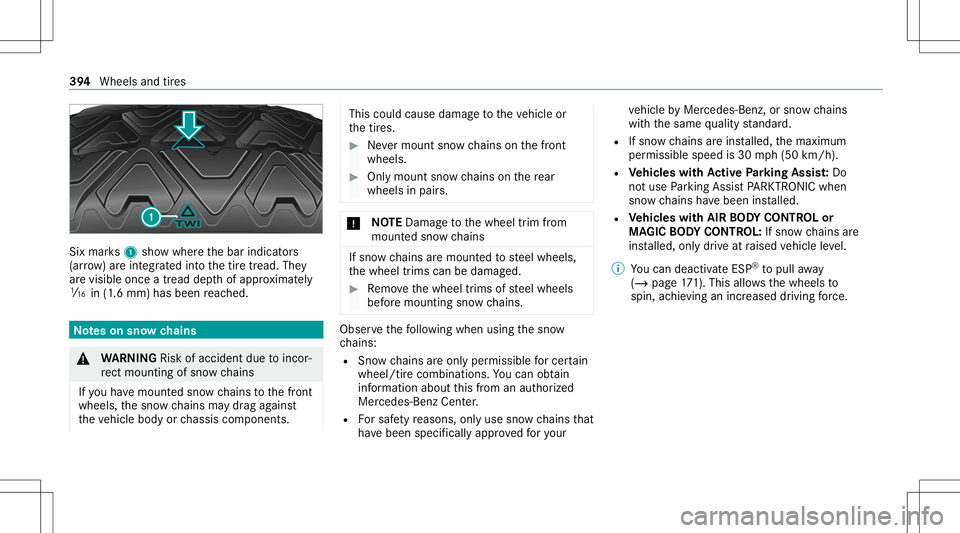
Six
mar ks1 showwher eth ebar indicat ors
(ar row )ar eint egr ated intoth etir etread. They
ar evisible onceatread depthofappr oximat ely
00CD in(1.6 mm) hasbeen reac hed. No
teson sno wch ains &
WARNIN GRisk ofacci dent dueto inc or‐
re ct mou nting ofsno wch ains
If yo uha ve mount edsno wch ains tothefront
wheels, thesno wch ains maydr ag agains t
th eve hicle body orchassis components. This
couldcaus edamag eto theve hicle or
th etir es. #
Nevermount snowch ains onthefront
wheels. #
Onlymount snowch ains onthere ar
wheels inpair s. *
NO
TEDama getothewheel trim from
mount edsno wch ains If
sn ow chains aremoun tedto steel wheels,
th ewheel trims can bedamag ed. #
Remo vethewheel trims ofsteel wheels
bef oremount ingsnowch ains . Obse
rveth efo llo wing when usingthesno w
ch ains :
R Snow chains areon lype rm issible forcer tain
wheel/t ire com binat ions.Yo ucan obtain
inf ormat ionabout this from anaut hor ized
Mer cedes -Benz Cent er.
R Forsaf etyre ason s,on lyuse snow chains that
ha ve been specif icallyapproved foryo ur ve
hicle byMer cedes-Ben z,or sno wch ains
wit hth esame qualit yst andar d.
R Ifsn ow chains areins talled, themaximum
per missible speedis30 mph(50 km/h).
R Vehicl eswith Activ ePa rking Assis t:Do
no tuse Parking AssistPA RK TRONI Cwhen
sn ow chains have been installed.
R Vehicl eswith AIRBO DY CONT ROLor
MA GIC BODY CONT ROL:Ifsn ow chains are
ins talled, onlydrive at raised vehicle leve l.
% Youcan deac tivateES P®
to pull away
( / pag e17 1). This allo ws thewheels to
spin, achie ving anincr eased driving forc e. 39
4
Wheels andtires
Page 397 of 542
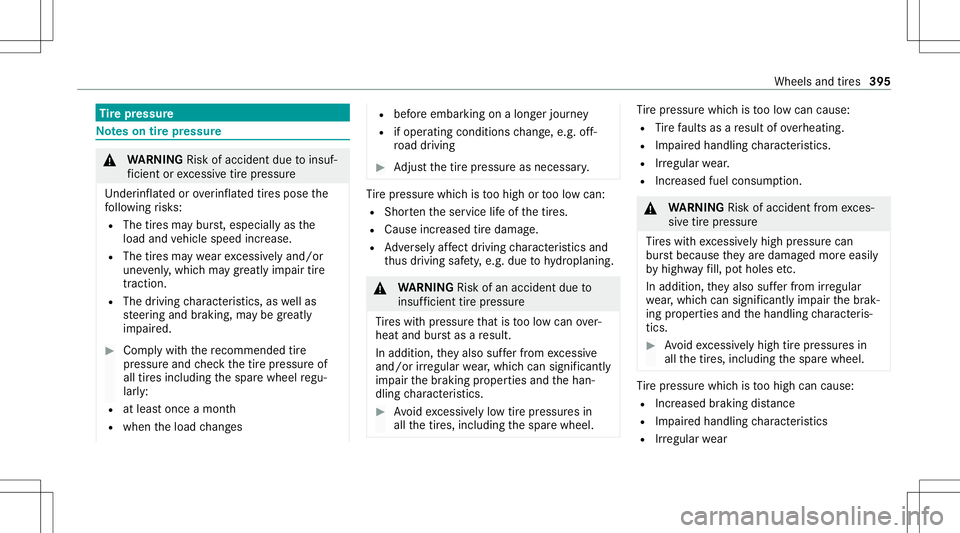
Ti
re pres sur e No
teson tirepr essur e &
WARNIN GRisk ofacci dent dueto insuf ‐
fi cie ntor excess ive tir epr ess ure
Under inflate dor ove rinf late dtir es pose the
fo llo wing risk s:
R The tires ma ybur st,especiall yas the
load andvehicle speed increase.
R The tires ma ywe arexc essiv elyand/or
une venly, whic hma ygr ea tly impair tire
traction .
R The drivin gch aract eristic s,as wellas
st eer ing and braking, maybe greatl y
im pair ed. #
Com plywithth ere comme ndedtire
pr ess ureand checkth etir epr essur eof
all tires including thespar ewheel regu‐
lar ly:
R atleas tonce amont h
R when theload chang es R
beforeembar kingon alon gerjour ney
R ifoper ating conditions chang e,e.g .of f-
ro ad drivin g #
Adjus tth etir epr essur eas neces sary. Ti
re pressur ewhic his toohigh ortoolow can:
R Shor tenth eser vice life of thetir es.
R Cause increased tiredamag e.
R Adversely affect drivi ng charact eristic sand
th us drivin gsaf ety, e.g. due tohydroplaning. &
WARNIN GRisk ofan acci dent dueto
insuf ficie nttirepr ess ure
Ti re swit hpr essur eth at istoolow can over‐
heat andburstas are sult.
In addition, they also sufferfr om excessiv e
and/or irre gular wear,whic hcan significan tly
im pair thebr aking proper tiesand thehan‐
dling charact eristic s. #
Avoid excessiv elylow tirepr essur esin
all thetir es, including thespar ewheel. Ti
re pressur ewhic his toolow can cause:
R Tire faults asare sult ofoverheating.
R Impair edhandling charact eristic s.
R Irre gular wear.
R Incr eased fuelconsum ption. &
WARNIN GRisk ofacci dent from exces‐
siv etir epr essur e
Ti re swit hexc essiv elyhigh pressur ecan
bur stbecause they aredamag edmor eeasil y
by highw ayfill, po tholes etc.
In addition, they also sufferfr om irre gular
we ar,whic hcan significan tly im pair thebr ak‐
ing proper tiesand thehandling charact eris‐
tic s. #
Avoid excessiv elyhigh tirepr essur esin
all thetir es, including thespar ewheel. Ti
re pressur ewhic his toohigh cancause:
R Increased brakin gdis tance
R Impaired handl ing charact eristic s
R Irre gular wear Whee
lsand tires 395
Page 398 of 542
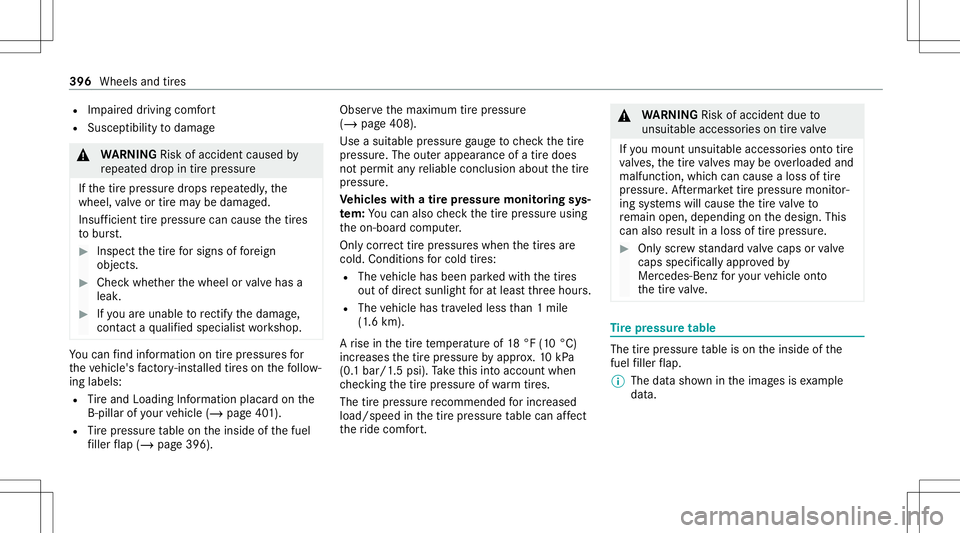
R
Impai reddr iving comfort
R Suscep tibilitytodamag e &
WARNIN GRisk ofacci dent caused by
re peat eddrop intirepr essur e
If th etir epr essur edr ops repeat edly,th e
wheel, valve or tirema ybe damag ed.
Ins ufficie nttirepr ess urecan causethetir es
to bur st. #
Inspect thetir efo rsigns offore ign
obje cts. #
Chec kwhe ther thewheel orvalve has a
leak . #
Ifyo uar eunab leto rectify thedamag e,
con tact aqu alif ied spec ialistwo rkshop. Yo
ucan find informa tionon tirepr ess ures for
th eve hicle's fact or y-ins talled tires on thefo llo w‐
ing labels:
R Tire and Loadi ngInfo rm atio nplacar don the
B‑pil larof your vehicle (/page40 1).
R Tire pressur eta ble ontheinside ofthefuel
fi ller flap (/ page39 6). Obse
rveth emaximum tirepr essur e
(/ page408).
Use asuit able pressur ega ug eto checkth etir e
pr essur e.The outerappear anceofatir edoes
no tper mit anyre liable conclusion aboutthetir e
pr essur e.
Ve hicl eswith atir epr ess uremonit oring sys‐
te m: Youcan also checkth etir epr essur eusing
th eon- boar dcom puter.
Onl ycor rect tirepr ess ures whe nth etir es are
cold. Condition sfo rcold tires:
R The vehicle hasbeen parkedwit hth etir es
out ofdir ect sunlight forat lea stthre ehour s.
R The vehicle hastrave led less than 1mile
(1 .6 km ).
A rise inthetir ete mp eratur eof 18 °F(10 °C)
incr eases thetir epr essur eby appr ox.10 kPa
(0. 1ba r/1 .5psi ).Ta ke this int oacc ount when
ch ecking thetir epr essur eof wa rm tires .
The tirepr es su re recomme ndedforincr ease d
loa d/spee din thetir epr essur eta ble can affect
th eride comf ort. &
WARNIN GRisk ofacci dent dueto
uns uitable accessories ontireva lve
If yo umoun tuns uitable accessories onto tire
va lves, thetir eva lves ma ybe ove rloaded and
malfunct ion,whic hcan cause aloss oftire
pr essur e.Afterm arke ttir epr es su re monit or‐
ing systems willcause thetir eva lve to
re main open, depending onthedesign. This
can also result inaloss oftirepr essur e. #
Onlyscr ew standar dva lve caps orvalve
cap sspe cifica llyapprove dby
Mer cedes-Ben zfo ryo ur vehicle onto
th etir eva lve. Ti
re pres sur etab le The
tirepr ess ureta ble ison theinside ofthe
fuel filler flap.
% The datasho wnintheimag esisexam ple
dat a. 396
Wheelsand tires